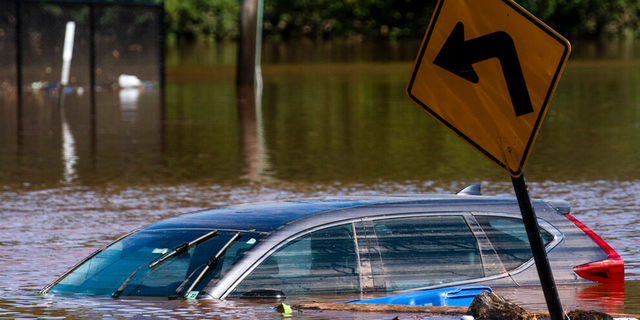Ida’s aftermath: Swollen rivers threaten new flooding in parts of Northeast as storms kill dozens
NYC faced first ‘flash flood emergency’ in its history
Fox News correspondent Bryan Llenas discusses historic flooding in the northeast on ‘Faulkner Focus’
As the remnants of Hurricane Ida walloped the Northeast, killing more than 50 people, other areas are bracing for the storm’s impact as swollen rivers are threatening additional flooding.
In Trenton, New Jersey, police officers were going door-to-door Wednesday night and Thursday morning encouraging residents to leave their homes in anticipation of the rising Delaware River. Flooding was anticipated at many Delaware River Basin locations and not expected to subside by Friday morning.
A car flooded on a local street as a result of the remnants of Hurricane Ida is seen in Somerville, N.J. Thursday, Sept. 2, 2021.
(AP)
Further north, in Fairfield, the Passaic River is forecast to crest more than 23 feet by Friday evening, police said.
Police there have closed at least 16 roads and warned that additional roads could be closed by the morning as the river continues to rise overnight.
Fairfield Mayor Jim Gasparini urged residents to take the warning seriously, advising that “even though the weather appears nice, river levels continue to rise and the township is expected to have widespread flooding that will affect many homes and businesses.”
The National Weather Service anticipates area rivers will crest and overflow through Friday.
“For the northeast north New Jersey rivers, we’re still seeing minor to moderate with locally, major flooding along those rivers,” James Tomasini from the Brookhaven National Weather Service told The Record.
North Jersey officials are keeping a close watch on the Passaic, Hackensack, Pequannock, and Rockaway rivers.
The National Hurricane Center had warned since Tuesday of the potential for “significant and life-threatening flash flooding” and major river flooding in the mid-Atlantic region and New England.
Hurricane Ida struck Louisiana as the fifth-strongest storm to ever hit the U.S. mainland, leaving 1 million people without power – potentially for weeks.
The Associated Press contributed to this report.
Source: Read Full Article

